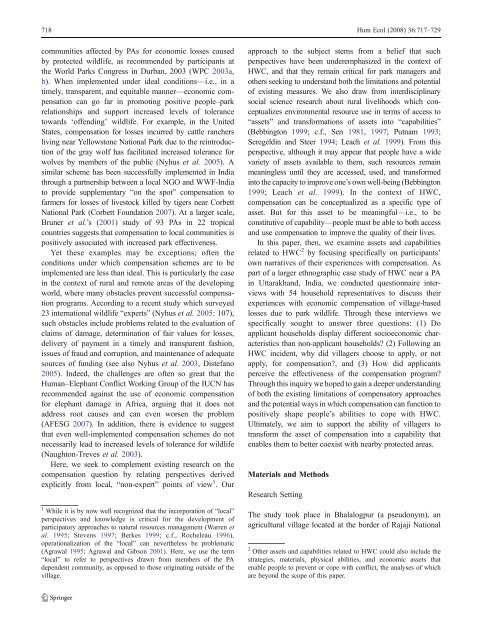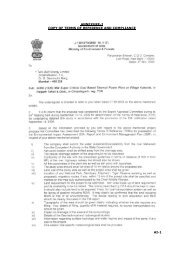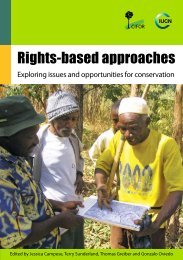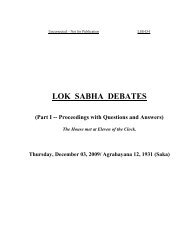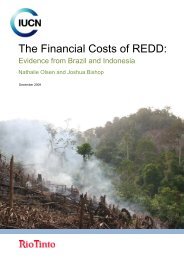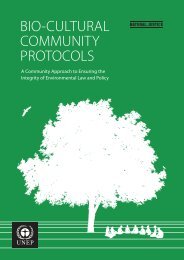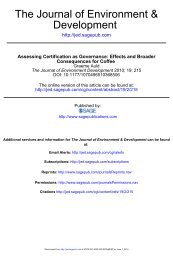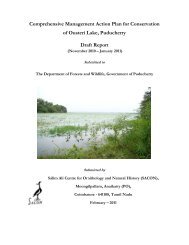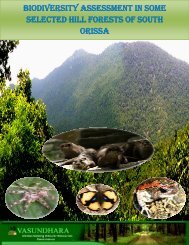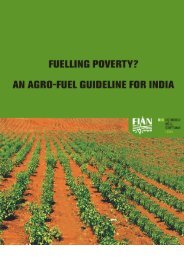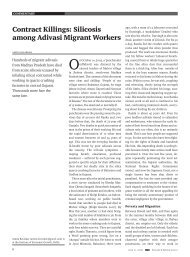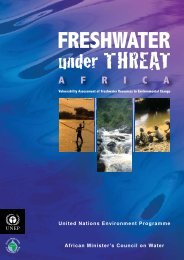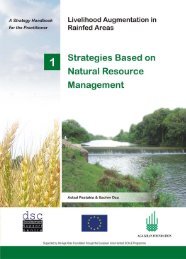Compensating Human–Wildlife Conflict in Protected Area - India ...
Compensating Human–Wildlife Conflict in Protected Area - India ...
Compensating Human–Wildlife Conflict in Protected Area - India ...
Create successful ePaper yourself
Turn your PDF publications into a flip-book with our unique Google optimized e-Paper software.
718 Hum Ecol (2008) 36:717–729<br />
communities affected by PAs for economic losses caused<br />
by protected wildlife, as recommended by participants at<br />
the World Parks Congress <strong>in</strong> Durban, 2003 (WPC 2003a,<br />
b). When implemented under ideal conditions—i.e., <strong>in</strong> a<br />
timely, transparent, and equitable manner—economic compensation<br />
can go far <strong>in</strong> promot<strong>in</strong>g positive people–park<br />
relationships and support <strong>in</strong>creased levels of tolerance<br />
towards ‘offend<strong>in</strong>g’ wildlife. For example, <strong>in</strong> the United<br />
States, compensation for losses <strong>in</strong>curred by cattle ranchers<br />
liv<strong>in</strong>g near Yellowstone National Park due to the re<strong>in</strong>troduction<br />
of the gray wolf has facilitated <strong>in</strong>creased tolerance for<br />
wolves by members of the public (Nyhus et al. 2005). A<br />
similar scheme has been successfully implemented <strong>in</strong> <strong>India</strong><br />
through a partnership between a local NGO and WWF-<strong>India</strong><br />
to provide supplementary “on the spot” compensation to<br />
farmers for losses of livestock killed by tigers near Corbett<br />
National Park (Corbett Foundation 2007). At a larger scale,<br />
Bruner et al.’s (2001) study of 93 PAs <strong>in</strong> 22 tropical<br />
countries suggests that compensation to local communities is<br />
positively associated with <strong>in</strong>creased park effectiveness.<br />
Yet these examples may be exceptions; often the<br />
conditions under which compensation schemes are to be<br />
implemented are less than ideal. This is particularly the case<br />
<strong>in</strong> the context of rural and remote areas of the develop<strong>in</strong>g<br />
world, where many obstacles prevent successful compensation<br />
programs. Accord<strong>in</strong>g to a recent study which surveyed<br />
23 <strong>in</strong>ternational wildlife “experts” (Nyhus et al. 2005: 107),<br />
such obstacles <strong>in</strong>clude problems related to the evaluation of<br />
claims of damage, determ<strong>in</strong>ation of fair values for losses,<br />
delivery of payment <strong>in</strong> a timely and transparent fashion,<br />
issues of fraud and corruption, and ma<strong>in</strong>tenance of adequate<br />
sources of fund<strong>in</strong>g (see also Nyhus et al. 2003, Distefano<br />
2005). Indeed, the challenges are often so great that the<br />
Human–Elephant <strong>Conflict</strong> Work<strong>in</strong>g Group of the IUCN has<br />
recommended aga<strong>in</strong>st the use of economic compensation<br />
for elephant damage <strong>in</strong> Africa, argu<strong>in</strong>g that it does not<br />
address root causes and can even worsen the problem<br />
(AFESG 2007). In addition, there is evidence to suggest<br />
that even well-implemented compensation schemes do not<br />
necessarily lead to <strong>in</strong>creased levels of tolerance for wildlife<br />
(Naughton-Treves et al. 2003).<br />
Here, we seek to complement exist<strong>in</strong>g research on the<br />
compensation question by relat<strong>in</strong>g perspectives derived<br />
explicitly from local, “non-expert” po<strong>in</strong>ts of view 1 . Our<br />
1 While it is by now well recognized that the <strong>in</strong>corporation of “local”<br />
perspectives and knowledge is critical for the development of<br />
participatory approaches to natural resources management (Warren et<br />
al. 1995; Stevens 1997; Berkes 1999; c.f., Rocheleau 1996),<br />
operationalization of the “local” can nevertheless be problematic<br />
(Agrawal 1995; Agrawal and Gibson 2001). Here, we use the term<br />
“local” to refer to perspectives drawn from members of the PA<br />
dependent community, as opposed to those orig<strong>in</strong>at<strong>in</strong>g outside of the<br />
village.<br />
approach to the subject stems from a belief that such<br />
perspectives have been underemphasized <strong>in</strong> the context of<br />
HWC, and that they rema<strong>in</strong> critical for park managers and<br />
others seek<strong>in</strong>g to understand both the limitations and potential<br />
of exist<strong>in</strong>g measures. We also draw from <strong>in</strong>terdiscipl<strong>in</strong>ary<br />
social science research about rural livelihoods which conceptualizes<br />
environmental resource use <strong>in</strong> terms of access to<br />
“assets” and transformations of assets <strong>in</strong>to “capabilities”<br />
(Bebb<strong>in</strong>gton 1999; c.f., Sen 1981, 1997; Putnam 1993;<br />
Seregeld<strong>in</strong> and Steer 1994; Leachet al. 1999). From this<br />
perspective, although it may appear that people have a wide<br />
variety of assets available to them, such resources rema<strong>in</strong><br />
mean<strong>in</strong>gless until they are accessed, used, and transformed<br />
<strong>in</strong>to the capacity to improve one’s own well-be<strong>in</strong>g (Bebb<strong>in</strong>gton<br />
1999; Leach et al. 1999). In the context of HWC,<br />
compensation can be conceptualized as a specific type of<br />
asset. But for this asset to be mean<strong>in</strong>gful—i.e., to be<br />
constitutive of capability—people must be able to both access<br />
and use compensation to improve the quality of their lives.<br />
In this paper, then, we exam<strong>in</strong>e assets and capabilities<br />
related to HWC 2 by focus<strong>in</strong>g specifically on participants’<br />
own narratives of their experiences with compensation. As<br />
part of a larger ethnographic case study of HWC near a PA<br />
<strong>in</strong> Uttarakhand, <strong>India</strong>, we conducted questionnaire <strong>in</strong>terviews<br />
with 54 household representatives to discuss their<br />
experiences with economic compensation of village-based<br />
losses due to park wildlife. Through these <strong>in</strong>terviews we<br />
specifically sought to answer three questions: (1) Do<br />
applicant households display different socioeconomic characteristics<br />
than non-applicant households? (2) Follow<strong>in</strong>g an<br />
HWC <strong>in</strong>cident, why did villagers choose to apply, or not<br />
apply, for compensation?, and (3) How did applicants<br />
perceive the effectiveness of the compensation program?<br />
Through this <strong>in</strong>quiry we hoped to ga<strong>in</strong> a deeper understand<strong>in</strong>g<br />
of both the exist<strong>in</strong>g limitations of compensatory approaches<br />
and the potential ways <strong>in</strong> which compensation can function to<br />
positively shape people’s abilities to cope with HWC.<br />
Ultimately, we aim to support the ability of villagers to<br />
transform the asset of compensation <strong>in</strong>to a capability that<br />
enables them to better coexist with nearby protected areas.<br />
Materials and Methods<br />
Research Sett<strong>in</strong>g<br />
The study took place <strong>in</strong> Bhalalogpur (a pseudonym), an<br />
agricultural village located at the border of Rajaji National<br />
2 Other assets and capabilities related to HWC could also <strong>in</strong>clude the<br />
strategies, materials, physical abilities, and economic assets that<br />
enable people to prevent or cope with conflict, the analyses of which<br />
are beyond the scope of this paper.


